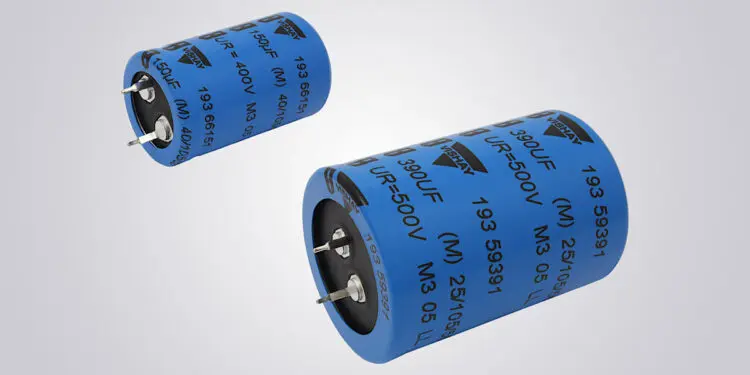Vishay introduced a new series of miniature snap-in power aluminum electrolytic capacitors that enable higher power density designs. The Vishay BCcomponents 193 PUR-SI series offers up to 30 % higher ripple current than standard solutions in similar case sizes, while providing a longer useful life.
With ripple currents up to 3.27 A, the devices released today allow designers to utilize fewer components to save board space and lower costs. Their long useful life of 5,000 hours at +105 °C permits use in demanding applications requiring more than 25 years lifetime from capacitors in ambient temperatures up to +60 °C.
Featuring a cylindrical aluminum case, insulated with a blue sleeve, 193 PUR-SI series devices feature rated voltages to 500 V in 25 compact case sizes ranging from 22 mm by 25 mm to 35 mm by 60 mm. The RoHS-compliant capacitors are also available with 3-pin keyed polarity snap-in terminals.
As polarized aluminum electrolytic capacitors with a non-solid electrolyte, the devices are ideally suited for smoothing, buffering, and DC-Link filtering in switch mode power supplies, motor drives, solar inverters, industrial air conditioners, and welding equipment.
Device Specification Table:
| Case size (D x L in mm) | 22 x 25 to 35 x 60 | |
| Capacitance range | 47 µF to 820 µF | |
| Tolerance | ± 20 % | |
| Rated voltage | 400 V to 450 V | 500 V |
| Category temperature range | -40 °C to +105 °C | -25 °C to +105 °C |
| Useful life at +105 °C | 5,000 h | |
| Max. ESR at 100 Hz | 120 mΩ to 2800 mΩ | |
| Max. impedance at 10 kHz | 80 mΩ to 2060 mΩ | |
| Sectional specification | IEC 60384-4 / EN130300 | |
| Climatic category IEC 60038 | 40 / 105 / 56 | 25 / 105 / 56 |
Samples and production quantities of the 193 PUR-SI series capacitors are available now, with lead times of 14 weeks.































